#knowledge ecology international
Text
Uncle Sam paid to develop a cancer drug and now one guy will get to charge whatever he wants for it

Today (Oct 19), I'm in Charleston, WV to give the 41st annual McCreight Lecture in the Humanities. Tomorrow (Oct 20), I'm at Charleston's Taylor Books from 12h-14h.

The argument for pharma patents: making new medicines is expensive, and medicines are how we save ourselves from cancer and other diseases. Therefore, we will award government-backed monopolies – patents – to pharma companies so they will have an incentive to invest their shareholders' capital in research.
There's plenty wrong with this argument. For one thing, pharma companies use their monopoly winnings to sell drugs, not invent drugs. For every dollar pharma spends on research, it spends three dollars on marketing:
https://www.bu.edu/sph/files/2015/05/Pharmaceutical-Marketing-and-Research-Spending-APHA-21-Oct-01.pdf
And that "R&D" isn't what you're thinking of, either. Most R&D spending goes to "evergreening" – coming up with minor variations on existing drugs in a bid to extend those patents for years or decades:
https://www.ncbi.nlm.nih.gov/pmc/articles/PMC3680578/
Evergreening got a lot of attention recently when John Green rained down righteous fire upon Johnson & Johnson for their sneaky tricks to prevent poor people from accessing affordable TB meds, prompting this excellent explainer from the Arm and A Leg Podcast:
https://armandalegshow.com/episode/john-green-part-1/
Another thing those monopoly profits are useful for: "pay for delay," where pharma companies bribe generic manufacturers not to make cheap versions of drugs whose patents have expired. Sure, it's illegal, but that doesn't stop 'em:
https://www.ftc.gov/news-events/topics/competition-enforcement/pay-delay
But it's their money, right? If they want to spend it on bribes or evergreening or marketing, at least some of that money is going into drugs that'll keep you and the people you love from enduring unimaginable pain or dying slowly and hard. Surely that warrants a patent.
Let's say it does. But what about when a pharma company gets a patent on a life-saving drug that the public paid to develop, test and refine? Publicly funded work is presumptively in the public domain, from NASA R&D to the photos that park rangers shoot of our national parks. The public pays to produce this work, so it should belong to the public, right?
That was the deal – until Congress passed the Bayh-Dole Act in 1980. Under Bayh-Dole, government-funded inventions are given away – to for-profit corporations, who get to charge us whatever they want to access the things we paid to make. The basis for this is a racist hoax called "The Tragedy Of the Commons," written by the eugenicist white supremacist Garrett Hardin and published by Science in 1968:
https://memex.craphound.com/2019/10/01/the-tragedy-of-the-commons-how-ecofascism-was-smuggled-into-mainstream-thought/
Hardin invented an imaginary history in which "commons" – things owned and shared by a community – are inevitably overrun by selfish assholes, a fact that prompts nice people to also overrun these commons, so as to get some value out of them before they are gobbled up by people who read Garrett Hardin essays.
Hardin asserted this as a historical fact, but he cited no instances in which it happened. But when the Nobel-winning Elinor Ostrom actually went and looked at how commons are managed, she found that they are robust and stable over long time periods, and are a supremely efficient way of managing resources:
https://pluralistic.net/2023/05/04/analytical-democratic-theory/#epistocratic-delusions
The reason Hardin invented an imaginary history of tragic commons was to justify enclosure: moving things that the public owned and used freely into private ownership. Or, to put it more bluntly, Hardin invented a pseudoscientific justification for giving away parks, roads and schools to rich people and letting them charge us to use them.
To arrive at this fantasy, Hardin deployed one of the most important analytical tools of modern economics: introspection. As Ely Devons put it: "If economists wished to study the horse, they wouldn’t go and look at horses. They’d sit in their studies and say to themselves, ‘What would I do if I were a horse?’"
https://pluralistic.net/2022/10/27/economism/#what-would-i-do-if-i-were-a-horse
Hardin's hoax swept from the fringes to the center and became received wisdom – so much so that by 1980, Senators Birch Bayh and Bob Dole were able to pass a law that gave away publicly funded medicine to private firms, because otherwise these inventions would be "overgrazed" by greedy people, denying the public access to livesaving drugs.
On September 21, the NIH quietly published an announcement of one of these pharmaceutical transfers, buried in a list of 31 patent assignments in the Federal Register:
https://public-inspection.federalregister.gov/2023-20487.pdf
The transfer in question is a patent for using T-cell receptors (TCRs) to treat solid tumors from HPV, one of the only patents for treating solid tumors with TCRs. The beneficiary of this transfer is Scarlet TCR, a Delaware company with no website or SEC filings and ownership shrouded in mystery:
https://www.bizapedia.com/de/scarlet-tcr-inc.html
One person who pays attention to this sort of thing is James Love, co-founder of Knowledge Ecology International, a nonprofit that has worked for decades for access to medicines. Love sleuthed out at least one person behind Scarlet TCR: Christian Hinrichs, a researcher at Rutgers who used to work at the NIH's National Cancer Institute:
https://www.nih.gov/research-training/lasker-clinical-research-scholars/tenured-former-scholars
Love presumes Hinrichs is the owner of Scarlet TCR, but neither the NIH nor Scarlet TCR nor Hinrichs will confirm it. Hinrichs was one of the publicly-funded researchers who worked on the new TCR therapy, for which he received a salary.
This new drug was paid for out of the public purse. The basic R&D – salaries for Hinrichs and his collaborators, as well as funding for their facilities – came out of NIH grants. So did the funding for the initial Phase I trial, and the ongoing large Phase II trial.
As David Dayen writes in The American Prospect, the proposed patent transfer will make Hinrichs a very wealthy man (Love calls it "generational wealth"):
https://prospect.org/health/2023-10-18-nih-how-to-become-billionaire-program/
This wealth will come by charging us – the public – to access a drug that we paid to produce. The public took all the risks to develop this drug, and Hinrichs stands to become a billionaire by reaping the rewards – rewards that will come by extracting fortunes from terrified people who don't want to die from tumors that are eating them alive.
The transfer of this patent is indefensible. The government isn't even waiting until the Phase II trials are complete to hand over our commonly owned science.
But there's still time. The NIH is about to get a new director, Monica Bertagnolli – Hinrichs's former boss – who will need to go before the Senate Health, Education, Labor and Pensions Committee for confirmation. Love is hoping that the confirmation hearing will present an opportunity to question Bertagnolli about the transfer – specifically, why the drug isn't being nonexclusively licensed to lots of drug companies who will have to compete to sell the cheapest possible version.

If you'd like an essay-formatted version of this post to read or share, here's a link to it on pluralistic.net, my surveillance-free, ad-free, tracker-free blog:
https://pluralistic.net/2023/10/19/solid-tumors/#t-cell-receptors


My next novel is The Lost Cause, a hopeful novel of the climate emergency. Amazon won't sell the audiobook, so I made my own and I'm pre-selling it on Kickstarter!
#pluralistic#pharma#incentives dont matter#incentives matter#drugs#uspto#nih#national institutes of health#cancer#patents#kei#knowledge ecology international#james love#jamie love#bayh-dole#bayh-dole act#tcr#scarlet tcr#t-cell receptor#Christian Hinrichs#entrepreneurial state#human papillomavirus#hpv#solid tumors#monopolies
547 notes
·
View notes
Text
So, I've decided to start learning biology.
My education left me with only primary school biology knowledge, because I had zero biology lessons in high school, and now I find myself sorely lacking in knowledge. Which is inconvenient, now that I'm sick and have no idea what to do. I didn't know where to start, but my roommate is in high school right now, and I borrowed her biology textbook to get myself started.
The biology textbook was so misinformed and outdated it made me worry for the education system. Not only they didn't update any info from the last 40 years, some of the info was completely wrong. For instance, it claims there's 6 billion people on the planet (there's 8), and that there's 6 empires of all living things (there's 8, and some of the old ones have been renamed and disputed). I learned quickly to fact-check every bit of information on wikipedia, and this is where I found some truly astounding info that I had no idea about.
If you all have learned this in highschool and it's common knowledge, please excuse me, but I am shocked.
One of the first topics the book covers is evolutionary history of the planet, and it explains how blue-green algae were the first historic plants to produce a lot of oxygen, which sounds like a positive development for us, because most of the living things right now thrive on oxygen. But, looking it up wikipedia uncovered that it was in fact, an extinction event. Most of life on earth was at that point, thriving in non-oxygen environment, and the introduction of oxygen killed 85% of all living species on earth. It was a huge disaster that happened! It's called 'Great Oxidation Event', or the 'Oxygen Catastrophe'.
But that's not all, I found out that it was not only that which destroyed almost all life on earth, but there's been 5 different events in the history that destroyed close to 80% of all species on the planet, and for some of them we don't even know why. We only found proof that lots of species disappeared at all times and the dominant species on the planet rapidly changed, but no idea why, for some of them it's assumed it has to do with volcanoes or ice, and of them that is well known is the meteor, that ended the big dinosaurs.
I never realized how much of evolution was destruction and then starting over, this was shocking to me. It was also fascinating, I found myself following links and learning more about extinction events, also that we're currently in the extinction event caused by humans who are driving lots of species into extinction by taking over their habitats, which made me sad.
At this point I started reading other, biology-related materials, for example, I read a book named 'What an Owl Knows', which is written by Jennifer Ackerman, an owl scientist who studied owls her entire life; now I know more about owls. I also started listening to an audio book about the ocean, and this one proved to be very difficult to follow, but I'll tell you what I learned from both.
The owl book was charming, I found out that owls are the most quiet, soundless birds when they fly, because their wings and feathers are the biggest part of their bodies. This is how they manage to swoop up prey without anyone hearing a single flap. They're also very silent and subtle. Unless you're studying owls, you won't be able to tell if the owl is startled, or scared, because she will sit very still and not give you any clues. Smaller owls can go into their 'freeze' response easily if they're being hunted, because their instinct is to be still and not move when in danger! It can make you feel like the owl is not scared, since she's not moving, but she is most likely not comfortable if anyone is approaching her.
Owls have similar faces to our faces, and they're very charismatic to us; this is why baby owls, and injured owls in human care, can sometimes imprint on humans. This is bad news for the owls, because once it happens, they can never again be released into the wild, they'll either never learn to hunt, or they'll act towards humans, like they do to other owls - brawling, attacking, aggressive, territorial. Even if they really like us, they will keep acting like we're other owl, not a different species. They see us similarly to how we see them.
One of the best information I've learned, is that in Serbia, there's the biggest gathering of owls of all species, there can be more than 300 owls in one place at the time. The reason for this is common use of old-fashined methods of harvesting grains, which leaves a lot of leftover corn and wheat on the ground, attracting mice, rats, and other small rodents, which creates a great food source for owls. Serbian farmers don't use rodenticide, so owls don't get poisoned. Owls so beloved and appreciated there, that they have an owl festival every year, and the whole month of november is called 'Sovember', because owl in serbian is 'sova'. I never knew about this, even though it's my neighbour country! I looked this up, and I found a website for the international owl festival, but I couldn't find any more info. I would appreciate it so much if any serbian followers could write me about this and tell me their experiences with it, I've never wanted to visit Serbia more!
The book contains information about owls used in Harry Potter movies, including the names of the owls, as well as discussing how the books made owls popular, and how it made people want them as pets. Owls do not make good pets, because they're predators and will destroy things and be very difficult to care for, but the book encourages readers to find the local owls and keep them safe, to leave old trees with holes in them standing, so the owls could nest in them, or to hang up baskets that can also be used as nests. It was a lovely, charming book and I recommend it to anyone who wants to know more about owls.
The ocean book is named 'How the Ocean Works', by Helen Czerski, and I haven't finished yet, but it opened up a lot of questions for me. The funniest part of it was the breakup of what people used to think about the ocean; apparently before research, people assumed that the sea is salty because it's been left in the sun for too long, and that's just what you get from sun exposure, they believed that deep down it was not salty anymore. They also believed that the sea water cannot go putrid if left standing. It took a scientist checking this to confirm it was not true; sea water did go putrid left in a bucket in the sun, and non-salty water did not turn salty when left in the sun for months. It was interesting to know that for the longest time, people didn't realize it was the salt in the sea that made it salty, I then wondered how they got salt, and it turns out they just got it from the salt mines, which are leftover from the long-dried up seas.
Now new information that I didn't know, was that the salinity is different between the oceans, the Atlantic is saltier than the rest. The book also explained about how the salt is connected to the currents, and to the movements of the sea, and also changes the density of the water. One thing that had me taken aback was that the ocean waves are not only caused by the wind, but the water is reacting to earth's rotation, and this rotation is constantly moving the water. It feels like the ocean is being pulled both by the earth and the moon, constantly being driven by planetary forces, which is interesting, because it's difficult to tell that just by looking.
The book calls ocean the 'blue machine', because it's always moving, and filled with energy. Sun is always warming up the surface, making it a great reservoir of solar energy, and the book goes on about how it's possible to harvest this energy, using hot water, and cold water, apparently there's already buildings being cooled down by the ocean power, but I never managed to figure out how! I tried looking it up, and also found nothing. I wish the book explained the physics of it, so that I could try it out, it's a great thing to be able to get power jut by using hot and cold water, and the water is already heated by the sun, while you can get cold water from the bottom of the sea.
I think I might understand this book better if I read it, rather than listening to the audiobook, which as you can see, just has me puzzled because I do not catch details. Still I wanted to share my new learnings, and ask if anyone can tell me more, or if this is all knowledge that people who had biology in high school already have. I'm having a great time learning, especially because I can just divert in any direction that has my interest, and I can seek out information that gives me useful, practical knowledge. Wish all learning processes could be free and inspired like this!
#biology#owls#ocean#evolution#extinction#learning biology#making up for lack of high school knowledge#information#resources#natural power#harvesting power from nature#ecology#international owl festival#serbia
77 notes
·
View notes
Text
Ethnobotany park interpretation
In recent years, ethnobotany parks have become increasingly popular as a way to explore the relationship between plants, people and culture. At ethnobotany parks, visitors can explore the traditional knowledge of Indigenous peoples, learn about the traditional uses of plants and explore the connection between plants and culture.
The concept of ethnobotany park interpretation is based on the idea…
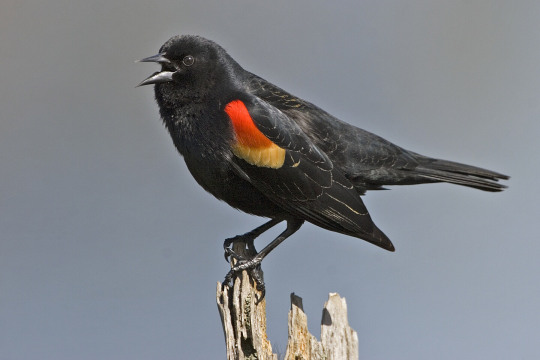
View On WordPress
#cultural education#cultural learning#cultural richness#cultural stories#ethnobotany#George Genereux Urban REgional Park#Indigenous#indigenous languages#Indigenous Ways of Knowing#International Decade of Indigenous Languages#Richard St. Barbe Baker AFforestation ARea#Saskatchewan#Saskatoon#traditional knowledge#Tradtional Ecological Knowledge
0 notes
Photo

Unlocking the Allure of Brooklyn Bridge Park: A Comprehensive Guide for Explorers"
Brooklyn Bridge Park, a gem nestled along the East River, stands as a testament to urban innovation, providing both locals and visitors with a stunning retreat. As you contemplate your visit, a cascade of questions might fill your mind. Fear not, as we embark on a journey to unravel the wonders of Brooklyn Bridge Park, addressing the queries that pique your curiosity.
Is there a cost to enter Brooklyn Bridge Park, or is it free for visitors?
One of the park's most enticing features is its accessibility—it's absolutely free! Brooklyn Bridge Park welcomes all, offering a respite from the bustling city without burning a hole in your pocket.
How can I access Brooklyn Bridge Park, and is there parking available?
Conveniently connected, the park is accessible by multiple modes of transport. Subway enthusiasts can alight at various nearby stations, while drivers will find ample parking options nearby. Whether you arrive by train, bus, or car, the journey to this urban oasis is as delightful as the destination itself.
Are pets allowed in Brooklyn Bridge Park, and are there designated areas for them?
Four-legged companions are more than welcome, making Brooklyn Bridge Park a haven for pet owners. Leash laws are in effect, ensuring a harmonious coexistence between humans and their furry friends. The park even boasts designated areas where pets can frolic freely.
What are the best spots for photography in Brooklyn Bridge Park?
Photographers, rejoice! The park offers a plethora of picturesque locations. Capture the iconic Manhattan skyline from the Pebble Beach, or frame the majestic Brooklyn Bridge against the setting sun from the Empire Fulton Ferry section. The possibilities for Instagram-worthy shots are endless.
What are the key attractions within Brooklyn Bridge Park?
Prepare to be enthralled by an array of attractions. From the impressive Pier 1 with its lush lawns to the tranquil gardens of Pier 6, each section tells a unique story. The famed Jane's Carousel, housed in an architectural masterpiece, is a must-visit, as is the renowned Brooklyn Bridge itself, standing proudly as the park's northern anchor.
How did the idea for Brooklyn Bridge Park originate, and when was it established?
The roots of Brooklyn Bridge Park trace back to community activism in the 1980s. What began as a vision to revitalize the waterfront burgeoned into reality in 2010 when the park officially opened its gates. Today, it stands as a testament to community-driven urban planning.
What recreational activities are available for visitors in Brooklyn Bridge Park?
Whether you're an avid sports enthusiast or a leisure seeker, the park caters to all. Engage in a game of basketball, try your hand at kayaking, or simply bask in the sun on the expansive lawns. The park hosts fitness classes, cultural events, and recreational sports leagues throughout the year.
Are there any family-friendly amenities or play areas within the park?
Families are in for a treat! The park offers playgrounds, water features, and a wealth of family-friendly programming. Spend quality time with your loved ones at Slide Mountain or embark on an adventure at the Water Lab, ensuring smiles for both the young and the young at heart.
Are there guided tours or educational programs offered at Brooklyn Bridge Park?
Delve deeper into the park's rich history and ecology through guided tours and educational programs. Knowledgeable guides unravel the layers of the park's past, present, and future, providing an enriching experience for visitors of all ages.
What are some of the popular dining options or food vendors in or around Brooklyn Bridge Park?
Savor diverse culinary delights from food vendors scattered throughout, offering everything from artisanal treats to international cuisines. Alternatively, nearby DUMBO and Brooklyn Heights boast a plethora of eateries catering to every palate.
In conclusion, Brooklyn Bridge Park is not merely a destination—it's an experience waiting to be embraced. Whether you're a local seeking solace or a visitor eager to explore, the park's dynamic offerings are sure to leave an indelible mark on your memory. So, lace up your walking shoes, charge your camera, and set forth on an adventure like no other!
#Brooklyn Bridge#Brooklyn#West Elm#Bench#Bridge#New York City#new york#newyork#New-York#nyc#NY#Manhattan#urban#city#USA#United States#buildings#travel#journey#outdoors#street#architecture#visit-new-york.tumblr.com#Brooklyn Bridge Park
863 notes
·
View notes
Text
Seed networks are community organizations that have multiplied in the past decade in different Brazilian biomes to collect, trade and plant native seeds in degraded areas.
In the Chapada dos Veadeiros area, in Goiás state members of seed networks from several parts of Brazil met for almost a week in early June.
Along with environmental organizations, researchers and government officials, they participated in discussions to boost Redário, a new group seeking to strengthen these networks and meet the demands of the country’s ecological restoration sector.
“This meeting gathered members of Indigenous peoples, family farmers, urban dwellers, technicians, partners, everyone together. It creates a beautiful mosaic and there’s a feeling that what we are doing will work and will grow,” says Milene Alves, a member of the steering committee of the Xingu Seed Network and Redário’s technical staff.
Just in 2022, 64 metric tons of native seeds were sold by these networks, and similar figures are expected for 2023.
The effort to collect native seeds by traditional populations in Brazil has contributed to effective and more inclusive restoration of degraded areas, and is also crucial for the country to fulfill its pledge under international agreements to recover 30 million acres of vegetation by 2030.
Seed collection for restoration in these areas has previously only been done by companies. But now, these networks, are organized as cooperatives, associations or even companies, enable people in the territories to benefit from the activity.
Eduardo Malta, a restoration expert from the Socio-Environmental Institute and one of Redário’s leaders, advocates for community participation in trading and planting seeds. “These are the people who went to all the trouble to secure the territories and who are there now, preserving them. They have the greatest genetic diversity of species and hold all the knowledge about the ecosystem,”
.
The Geraizeiros Collectors Network are one of the groups that makes up Redário. They were founded in 2021, and now gathers 30 collectors from eight communities in five municipalities: Montezuma, Vargem Grande, Rio Pardo de Minas, Taiobeiras and Berizal.
They collect and plant seeds to recover the vegetation of the Gerais Springs Sustainable Development Reserve, which was created in 2014 in order to stop the water scarcity as a result of eucalyptus monocultures planted by large corporations.
“The region used to be very rich in water and it is now supplied by water trucks or wells,” says Fabrícia Santarém Costa, a collector and vice president of the Geraizeiros Collectors’ Network. “Today we see that these activities only harm us, because the [eucalyptus] company left, and we are there suffering the consequences.”
Costa was 18 years old in 2018, when the small group of seed collectors was founded and financed by the Global Environmental Facility. She says that working with this cooperative changed the way she looks at life and the biome in which she was born and raised.
She describes restoring the sustainable development work as "ant work", ongoing, slow. But it has already improved the water situation in the communities. In addition, seed sales complement geraizeiros’ income, enabling them to remain in their territories.
.
The Redário initiative also intends to influence public policies and regulations in the restoration sector to disseminate muvuca, the name given by the networks to the technique of sowing seeds directly into the soil rather than growing seedlings in nurseries.
Technical studies and network experiences alike show that this technique covers the area faster and with more trees. As a result, it requires less maintenance and lower costs. This system also distributes income to the local population and encourages community organizations.
“The muvuca system has great potential [for restoration], depending on what you want to achieve and local characteristics. It has to be in our range of options for meeting the targets, for achieving them at scale,” says Ministry of the Environment analyst Isis Freitas.
Article published August 3rd, 2023
#long post#climate change#climate#hope#good news#more to come#climate emergency#positive news#hopeful#climate justice#news#important#good post#links
199 notes
·
View notes
Text
Also, biodiversity conservation and restoration is very cheap. Protecting 30% of the world's land and sea area would mean an investment of 140 billion dollars a year.
This is about a tenth of the value of trillion dollar corporations like Amazon, Nvidia or Google (not even getting into the double trillions like Apple or Microsoft). The US Military spends 840 billion dollars in its current budget, and probably more given the well known corruption and rampant spending. An international program could raise double of that.
The study also points out that, from tourism to jobs to many other benefits, the returns to the global economy would be 5 times the 140 billion investment.
This is all in a capitalist perspective where investment and profit rule all. In a socialist perspective, this shouldn't be an issue at all. We protect nature not because of profit, but because it is our home and the heritage to our children. Eventually, enviromental protection and ecological development should be what we do because we must do, because our planet is marvelous and our home, not because of what profit we can extract from it in one or other way.
Same with space exploration, by the way. Or global food and health programs. All the shit we spend on advertising or nuclear weapons can be used into protecting human dignity, expanding our knowledge and protecting our planet. It was true when hippies said it in the 70s and is still true now.
55 notes
·
View notes
Photo
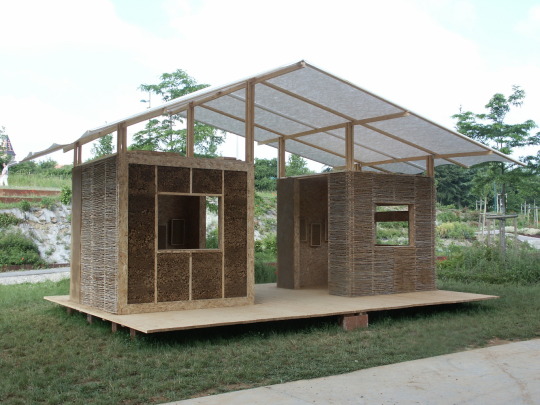
Pioneering the Revival of Earth Architecture: Egypt, France, and India
The current ecological crisis has sparked a renewed interest in ancient traditions, especially among architects. The need for reliable and sustainable eco-architecture has led many international architects to explore vernacular eco-construction. A common belief is that vernacular practices are embedded in their time, unable to find a place in the contemporary built environment. However, many examples across the world show how knowledgeable artisans are capable of re-utilizing their skills in new ways.
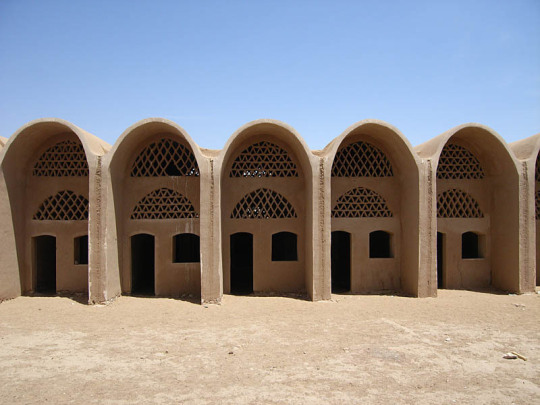



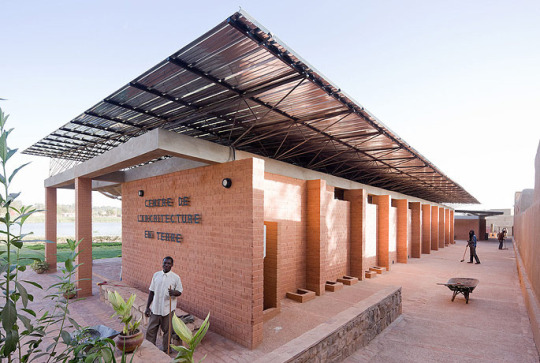
230 notes
·
View notes
Text
Think big. Despite its research topic, this could well be the motto of the Graphene Flagship, which was launched in 2013: With an overall budget of one billion Euros, it was Europe's largest research initiative to date, alongside the Human Brain Flagship, which was launched at the same time. The same applies to the review article on the effects of graphene and related materials on health and the environment, which Empa researchers Peter Wick and Tina Bürki just published together with 30 international colleagues in the scientific journal ACS Nano; on 57 pages, they summarize the findings on the health and ecological risks of graphene materials, the reference list includes almost 500 original publications.
A wealth of knowledge -- which also gives the all-clear. "We have investigated the potential acute effects of various graphene and graphene-like materials on the lungs, in the gastrointestinal tract and in the placenta -- and no serious acute cell-damaging effects were observed in any of the studies," says Wick, summarizing the results. Although stress reactions can certainly occur in lung cells, the tissue recovers rather quickly. However, some of the newer 2D materials such as boron nitrides, transition metal dichalcogenides, phosphenes and MXenes have not yet been investigated much, Wick points out; further investigations were needed here.
Read more.
14 notes
·
View notes
Text
141 (and friends) professional and personal Specialty Headcannons.
also I dipped for a hot minute but I spent that time reading twitter thread fics like the internet goblin I am and falling into the multi shipper hole that is PriceNik and poly141 so here are more Headcannons about our favs.
(also no I won't write Konig Headcannons, I don't like him. pls stop asking)
Areas of interest: academic and personal.
-soap is good at chemistry and chemical equations. the man has the periodic table tattooed on the back of his eyelids and nothing will stop him from making an IED out of literally the most random shit. also knows a concerning amount about atomic physics. but he also has a passion for all poetry and writes little sonnets in his sketchbook for his partners.
-Price is really good at languages. he's a certified multilingual and is constantly learning. his favourite part is learning niche regional dialects. he is fluent in conversation in all major languages and can speak conversationally in at least 30 others. he also really enjoys horticulture. he can name 50 different grasses according to Laswell.
- Ghost specialises in trigonometry. he can do it mentally on the fly and often comes out correct. he uses it in his sniping, allowing him to be sent on more solo missions, without the need for a spotter. coincidently his secondary talent is navigation, he is bizarrely good at maps and geo guessing games but also used to do orienteering tournaments before his “death”. after the alone mission, despite only being told where the safe house was, ghost seemed to find his way there, without a map, from a city he had only been in for like a week. I like to think his internal sense of direction is like homing pigeon level. you could stick him anywhere and he could immediately find his way back.
-Gaz is an all-round science man, a jack-of-all-trades. he has a comprehensive knowledge of biology, chemistry, physics, geology and the niche areas as well. zoology, astrophysics, ecology, palaeontology, psychology, genetics astronomy, botany, microbiology and the list goes on. you'll never meet someone with so much knowledge of the natural, social and formal sciences. he's not at university level but he has a thorough understanding of the concepts and case studies for all. he can comprehend the advanced concepts as well. its helped the 141 out of some tight spots. coincidently his personal interest is reading. his room on base and his apartment is full of academic journals and natgeo magazines.
-Alejandro. Mechanical engineering. The colonel of the Los Vaqueros can fix anything with duct tape and a prayer, but he also can build the most robust (and more importantly) high-functioning machinery. all repairs to their vehicles and heavy weaponry on base are done by Alejandro, simply because he doesn’t trust anyone else with the machines that keep his men safe. he also enjoys doing it, it gives him some time to wind down and just tinker with things. His secret talent is weaving and braiding. he was taught by his abuela to not only weave scarves and things like carpets, but also to braid her hair and his sisters once she got too old. (I head cannon him as the oldest and they all lived with their grandma cause their parents died.) he used to braid Valerias hair (as an mlm/wlw besties thing) before she betrayed them. he braided Gaz’s hair once they bonded over engineering.
-Rudolfo. Rudy is an expert in law. more specifically domestic and international criminal law, but he also keeps up with all legal disciplines. due to the proximity of Las Almas to the border, he also keeps up to date with USA law. He's a life saver in sticky jurisdiction missions. he also manages the compounds paperwork for requests. he has a silver tongue that translates to requisition forms. his personal passion is painting though. he feels that sometimes words aren't enough to describe things and loves painting landscapes and the little moments, like a flowering cactus in the middle of the night but also its death the next morning. he knows how fleeting life can be in his profession, and wants to capture all aspects. hopefully more with Ale if they retire.
-Laswell. Algorithms. typical of a spook Kate is an expert in cryptographic algorithms. she spent a few years as a cipher breaker/creator in her early career and hasn't lost her touch since moving to intelligence. all of her transmissions to her sources are hand encrypted and they have a key delivered separately. she creates them herself so that they can't be deciphered. she also does it completely in her head, nothing is typed out. her time off is spent back on her wife's farm, as her passion is animal husbandry. they raise goats, sheep, some assorted fowl and a smaller herd of cattle together. she has an Australian Shepard and a kelpie/blue heeler dog that she trained herself.
-Nik is an expert in psychology. not in your typical clinical way, but the body language, tone of voice, mindset and “takes one look and deciphers your whole life” way. His experience is immense and he applies it all the time. he can tell when a prisoner is lying in interrogation and when he's been made during undercover. Nik knows people, and frequently uses his observations to do things like blatantly walk into a restricted area with only confidence and a blank lanyard. the Russian is unparalleled in putting himself in the enemies mind space or pulling off dangerous acts in a crowded area. he’s been teaching gaz some tricks (e.g. the Amsterdam cafe mission). But on the side, he is an excellent barber. haircuts of any length and a full on old fashioned shave, with a straight razor and everything, is his special talent. he does price’s moustache, Jonnys mohawk (even though he thinks its ugly when short), learnt how to give gas a full hair treatment and even does Kates hair. he uses it for missions of course (its a great source of intel) but he also finds it to be a way to show care to his people.
bonus:
Valeria: main specialty-economics and accounting. special interest-botany (but strictly focusing on poisonous and hallucinogenic plants)
Graves: main specialty: aeronautics. special interest-being a backstabbing bitch? jk, he's actually super into smoking and curing meats. if he had joined 141 he and ghost would have eventually found common ground there. (ghost actually enjoyed his career as a butchers apprentice)
anyway that's it for now, and I'll try upload more often. feel free to repost on other platforms with credit, my twitter @ is @macG_Unit. also let me know if anyone writes pics based off these, id love to read them.
#cod mwii#cod mw22#john soap mactavish#simon ghost riley#john price#kyle gaz garrick#laswell mw2#kate laswell#alejandro vargas#rudolfo parra#nikolai cod#valeria cod#graves mw2
73 notes
·
View notes
Text
Man-At-Legs (Monster)

(man-at-legs by nodoame1215)
(Pikmin! The man-at-legs is certainly one of the more dystopian-looking creatures, fitting the rusted metal of Pikmin 2's dungeons. It's quite the intrusion on the colorful ghibliesque aesthetic most of the series has, and all the more memorable for it. Also, it's shooting you with a freakin' machine gun!)
CR13 LN Huge Aberration
Man-at-legs are the colloquial name for an ancient biomechanical war machine, a mutilation of the purely organic beady longlegs for more offensive tactical use. They are equipped with a cold AI, armored plating, and an internalized turret that serves their main goal- eradicating the enemies of their creators. Man-at-legs are typically found buried and inactive, where they can rest for millenia at a time, waking only when an unfortunate soul triggers its biosensors and is calculated as a target. Man-at-legs are given energy by strange biomechanical processes that make them functionally immortal, provided a good source of metals or radiation is available.
There exist miniaturized test subjects of the man-at-legs, creatures no bigger than a songbird but still capable of violence in their own right.
This creature appears to be a mechanical probe, with an orbular body and long metal legs, but it opens its lower half to reveal it’s held together by sinuous flesh- and wielding a mechanical gun.
Misc- CR13 LN Huge Aberration HD18 Init:+13 Senses: Perception: +25 Blindsight 120ft
Stats- Str:21(+5) Dex:28(+9) Con:16(+3) Int:12(+1) Wis:19(+4) Cha:1(-5) BAB:+13/+8/+3 Space:15ft Reach:5ft
Defense- HP:135(18d8+54) AC:32(+9 Dex, -2 Size, +8 Armor, +6 Natural, +1 Dodge) Fort:+9 Ref:+13 Will:+14 CMD:39 Resist: Cold 10, Electricity 10, Fire 10 Immunity: Visual Effects Weakness: Metal Plating Special Defenses: DR5/Bludgeoning
Offense- Slam +16(2d6+7) CMB:+20 Speed:40ft, Burrow 20ft Special Attacks: 2 Machine Gun +18(5d6, 90ft), Death Throes (DC19 Reflex)
Feats- Iron Will, Dodge, Mobility, Great Fortitude, Improved Initiative, Vital Strike, Point-Blank Shot, Shot on the Run, Improved Vital Strike
Skills- Acrobatics +30, Disable Device +27, Knowledge (Engineering) +22, Perception +25, Stealth +22
Special Qualities- No Breath
Ecology- Environment- Urban Languages- Common (Can’t Speak) Organization- Solitary Treasure- Standard
Special Abilities-Death Throes (Ex)- A man-at-legs explodes 1 round after its death, dealing 18d6 damage that is half fire and half force to creatures within 30ft, DC19 Reflex save for half Machine Gun (Ex)- As a full-round action, a man-at-legs may open its chassis and fire the machine gun within. Treat this as an automatic gun (as per rules on Modern Firearms) with a range of 90ft that deals 5d6 damage. The man-at-legs fires two bursts. Metal Plating (Ex)- A man-at-legs’ mechanical and biological aspects are not purely harmonious, and can be taken advantage of. A spell such as Warp Metal or Transmute Metal to Wood deals 1d6 damage per caster level to a man-at-legs, although the man-at-legs gets a fortitude save for half.
37 notes
·
View notes
Text

Chapter 4. Environment
What about global environmental problems, like climate change?
Anarchists do not yet have experience dealing with global problems because our successes so far have only been local and temporary. Stateless, anarchic societies once covered the world, but this was long before the existence of global environmental problems like those created by capitalism. Today, members of many of these indigenous societies are at the forefront of global resistance to the ecological destruction caused by governments and corporations.
Anarchists also coordinate resistance globally. They organize international protests against major polluters and their state backers, such as the mobilizations during the G8 summits that have convened hundreds of thousands of people from dozens of countries to demonstrate against the states most responsible for global warming and other problems. In response to the global activity of transnational corporations, ecologically-minded anarchists share information globally. In this manner, activists around the world can coordinate simultaneous actions against corporations, targeting a polluting factory or mine on one continent, retail stores on another continent, and an international headquarters or shareholders’ meeting on another continent.
For example, major protests, boycotts, and acts of sabotage against Shell Oil were coordinated among people in Nigeria, Europe, and the North America throughout the 1980s and ’90s. In 1986, autonomists in Denmark carried out multiple simultaneous fire bombings of Shell stations across the country during a worldwide boycott to punish Shell for supporting the government responsible for apartheid in South Africa. In the Netherlands, the clandestine anti-authoritarian group RARA (Revolutionary Anti-Racist Action) carried out a campaign of nonlethal bombings against Shell Oil, playing a crucial role in forcing Shell to pull out of South Africa. In 1995, when Shell wanted to dump an old oil rig in the North Sea, it was forced to abandon its plans by protests in Denmark and the UK, an occupation of the oil rig by Greenpeace activists, and a fire bombing and a shooting attack against Shell stations in two different cities in Germany as well as a boycott that lowered sales by ten percent in that country.[67] Efforts such as these prefigure the decentralized global networks that could protect the environment in an anarchist future. If we succeed in abolishing capitalism and the state, we will have removed the greatest systemic ravagers of the environment as well as the structural barriers that currently impede popular action in defense of nature.
There are historical examples of stateless societies responding to large scale, collective environmental problems through decentralized networks. Though the problems were not global, the relative distances they faced — with information traveling at a pedestrian’s pace — were perhaps greater than the distances that mark today’s world, in which people can communicate instantaneously even if they live on opposite sides of the planet.
Tonga is a Pacific archipelago settled by Polynesian peoples. Before colonization, it had a centralized political system with a hereditary leader, but the system was far less centralized than a state, and the leader’s coercive powers were limited. For 3,200 years, the people of Tonga were able to maintain sustainable practices over an archipelago of 288 square miles with tens of thousands of inhabitants.[68] There was no communications technology, so information travelled slowly. Tonga is too large for a single farmer to have knowledge of all the islands or even all of any of its large islands. The leader was traditionally able to guide and ensure sustainable practices not through recourse to force, but because he had access to information from the entire territory, just as a federation or general assembly would if the islanders organized themselves in that way. It was up to the individuals who made up the society to implement particular practices and support the idea of sustainability.
The fact that a large population can protect the environment in a diffuse or decentralized manner, without leadership, is amply demonstrated by the aforementioned New Guinea highlanders. Agriculture usually leads to deforestation as land is cleared for fields, and deforestation can kill the soil. Many societies respond by clearing more land to compensate for lower soil productivity, thus aggravating the problem. Numerous civilizations have collapsed because they destroyed their soil through deforestation. The danger of soil erosion is accentuated in mountainous terrain, such as the New Guinea highlands, where heavy rains can wash away denuded soil en masse. A more intelligent practice, which the farmers in New Guinea perfected, is silvaculture: integrating trees with the other crops, combining orchard, field, and forest to protect the soil and create symbiotic chemical cycles between the various cultivated plants.
The people of the highlands developed special anti-erosion techniques to keep from losing the soil of their steep mountain valleys. Any particular farmer might have gained a quick advantage by taking shortcuts that would eventually cause erosion and rob future generations of healthy soil, yet sustainable techniques were used universally at the time of colonization. Anti-erosion techniques were spread and reinforced using exclusively collective and decentralized means. The highlanders did not need experts to come up with these environmental and gardening technologies and they did not need bureaucrats to ensure that everyone was using them. Instead, they relied on a culture that valued experimentation, individual freedom, social responsibility, collective stewardship of the land, and free communication. Effective innovations developed in one area spread quickly and freely from valley to valley. Lacking telephones, radio, or internet, and separated by steep mountains, each valley community was like a country unto itself. Hundreds of languages are spoken within the New Guinea highlands, changing from one community to the next. Within this miniature world, no one community could make sure that other communities were not destroying their environment — yet their decentralized approach to protecting the environment worked. Over thousands of years, they protected their soil and supported a population of millions of people living at such a high population density that the first Europeans to fly overhead saw a country they likened to the Netherlands.
Water management in that lowland northern country in the 12th and 13th centuries provides another example of bottom-up solutions to environmental problems. Since much of the Netherlands is below sea level and nearly all of it is in danger of flooding, farmers had to work constantly to maintain and improve the water management system. The protections against flooding were a common infrastructure that benefited everybody, yet they also required everyone to invest in the good of the collective to maintain them: an individual farmer stood to gain by shirking water management duties, but the entire society would lose if there were a flood. This example is especially significant because Dutch society lacked the anarchistic values common in indigenous societies. The area had long been converted to Christianity and indoctrinated in its ecocidal, hierarchical values; for hundreds of years it had been under the control of a state, though the empire had fallen apart and in the 12th and 13th centuries the Netherlands were effectively stateless. Central authority in the form of church officials, feudal lords, and guilds remained strong in Holland and Zeeland, where capitalism would eventually originate, but in northern regions such as Friesland society was largely decentralized and horizontal.
At that time, contact between towns dozens of miles apart — several days’ travel — could be more challenging than global communication in the present day. Despite this difficulty, farming communities, towns, and villages managed to build and maintain extensive infrastructure to reclaim land from the sea and protect against flooding amid fluctuating sea levels. Neighborhood councils, by organizing cooperative work bands or dividing duties between communities, built and maintained the dykes, canals, sluices, and drainage systems necessary to protect the entire society; it was “a joint approach from the bottom-up, from the local communities, that found their protection through organizing themselves in such a way.”[69] Spontaneous horizontal organizing even played a major role in the feudal areas such as Holland and Zeeland, and it is doubtful that the weak authorities who did exist in those parts could have managed the necessary water works by themselves, given their limited power. Though the authorities always take credit for the creativity of the masses, spontaneous self-organization persists even in the shadow of the state.
#environmentalism#environment#solarpunk#anti colonialism#anarchism#daily posts#communism#anti capitalist#anti capitalism#late stage capitalism#anarchy#anarchists#libraries#leftism#social issues#economy#economics#climate change#anarchy works
8 notes
·
View notes
Text


Mexican biologist Yuliana Bedolla
Off Mexico's west coast, the Baja California Pacific Islands are key global nesting sites for 23 seabird species and Natividad Island shelters 90 percent of the breeding population of the Black-vented Shearwater (Puffinus opisthomelas).
Mexican conservation biologist Yuliana Rocío Bedolla Guzmán, Director of the Marine Birds Project at Grupo de Ecología y Conservación de Islas (GECI) says that invasive mammals like cats and rats wiped out at least 27 seabird colonies in the past.
The researchers have been working with fishing cooperatives to decrease the likelihood of reintroductions that would lead to expensive eradication efforts.
"In 2021, we created the local community group “Líderes Comunitarios'' formed by enthusiastic and committed women who have received formal training on island biosecurity and bird identification, and are becoming agents of change in their communities," Bedolla says.
Recently, Bedolla won a 2023 Whitley Award from UK charity Whitley Fund for Nature (WFN) and will use the funding to boost the role of local women and fishing cooperative.
"The goal is to continue preventing the accidental introduction of invasive mammals on Natividad and San Benito Oeste islands by actively involving local leaders and fishing cooperatives in biosecurity protocols," she says.
"My Grain of Sand"
Bedolla grew up far from the sea in Moroleón, a small town in central Mexico, where she enjoyed being out in nature.
"But I had my Eureka moment when I learned to snorkel when I was 12 years old at a beach in Zihuatanejo, Guerrero, in the Mexican Pacific," she says adding that she remembered a feeling of amazement, wonder and a new sense of connection to nature.
"That experience was life-changing for me and marked the beginning of my journey as a conservationist," Bedolla says, "From that moment on, I knew I wanted to become a marine biologist and contribute with my grain of sand."
She would go on to study Marine Biology at the Universidad Autónoma de Baja California Sur in La Paz, Baja California Sur, Mexico, learning to dive and study coral reefs and associated invertebrates on several islands in the Gulf of California.
Bedolla would contact GECI in the course of her masters degree and years later, after a Phd in Germany, GECI offered her the directorship of the Marine Birds Project.
Bedolla says that being from the Global South helps her to bring diverse perspectives and approaches to scientific research, which can lead to more innovative and creative solutions.
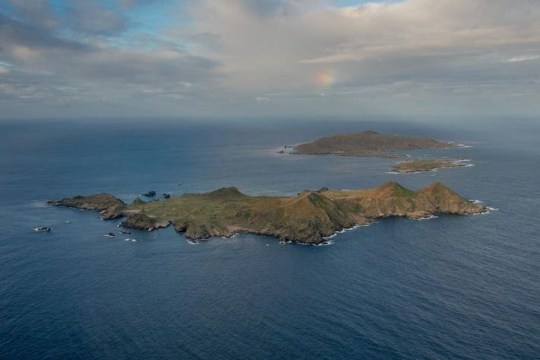
The San Benito Islands, which is among the islands Yuliana Bedolla is trying to protect from invasive species
Yuliana is a marine biologist, graduated with honors from the Autonomous University of Baja California Sur (UABCS).
She is a Master in Coastal Oceanography from the Autonomous University of Baja California (UABC) and a PhD candidate from the Justus Liebig University of Giessen in Germany. For her doctorate, she obtained a scholarship in Germany. Yuliana speaks Spanish and English and has basic knowledge of the German language. Her doctoral research focuses on the foraging ecology of three petrel species that nest in the San Benito Archipelago, in the Pacific of Baja California.
She began collaborating with the Ecology and Conservation of Islands Group, A.C., (GECI), in 2009 as a field biologist, and is currently the director of the Seabird Project, which aims to restore and conserve seabirds through the use of social attraction systems in conjunction with systematic monitoring, research and environmental education. She has carried out numerous research studies with national and international institutions. Her scientific publications in international journals focus on the response of seabirds to environmental conditions, the parasites that infect seabirds and the response of native fauna to the eradication of invasive mammals.
She has collaborated with several national seabird conservation programs and has been directly involved in environmental restoration projects in Isla Isabel, San Benito Archipelago, Banco Chinchorro and Arrecife Alacranes, related to the eradication of invasive rodents for the benefit of seabird colonies, among other island species. Her activities at GECI include project planning, staff coordination and supervision, applied research and monitoring, environmental education with local communities and dissemination of information in conferences and scientific reports and publications.
Source
#🇲🇽#Yuliana Rocío Bedolla Guzmán#STEM#mexico#baja california#pacific islands#animal#bird#rat#cat#GECI#2023 Whitley Award#Universidad Autónoma de Baja California Sur#Marine Birds Project#san benito islands#ecuador#banco chinchorro#scorpion reef#gulf of mexico#mexican#latina#hispanic#natividad island#Grupo de Ecología y Conservación de Islas
33 notes
·
View notes
Photo


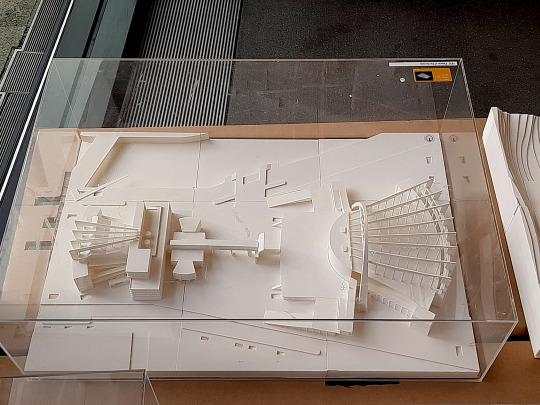

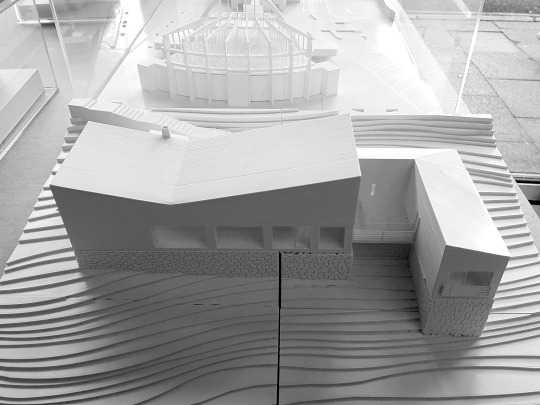




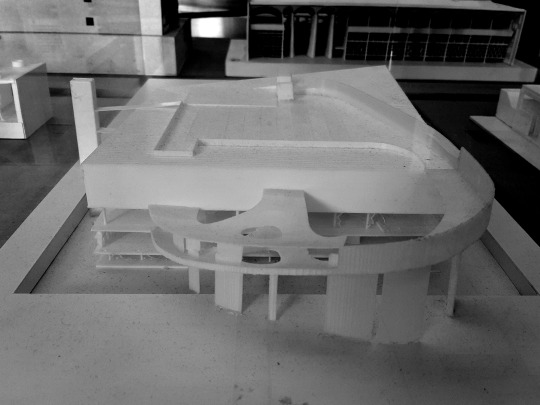
"Le Corbusier’s Models of Worldmaking"_ London South Bank University _ 21.03.2023 - 06.04.2023
The School of The Built Environment and Architecture at London South Bank University (#LSBU) hosts an international symposium, reconsidering an exhibition of 150+ models of Le Corbusier’s built and unbuilt projects.
The Symposium will take place in:
Lecture Theatre A, Keyworth Centre, London South Bank University (#LSBU), Keyworth Street, London SE1 6NG.
Thursday 30 March 2023, 17:30'-20:30'
Registration link:
https://www.eventbrite.co.uk/e/le-corbusiers-models-of-worldmaking-tickets-592126023877
The exhibition of models is open to the public from 21 March to 06 April 2023 in the foyer of Keyworth Centre, #LSBU.
Since the early 20th century Le Corbusier’s projects have been unavoidable points of reference in architectural knowledge and practice. Their roles, however, have changed historically from avant-garde and polemic statements of icons of the modernist movement, to stigmatised and politically charged constructions, and, in recent years, to contested grounds for reflections on ethical, socially-aware, and ecologically-just practices. His projects, whether built or unbuilt, operate in the tension between architecture imagined and architecture conceived. This space in-between is precisely the quality that turns them into the driving force for progression and reconsideration of the field of architecture. Their discursive, imaginative, and projective qualities have produced socio-spatial imaginaries and expressible fantasies. The symposium celebrates an exhibition of 156 models of Le Corbusier’s built and unbuilt projects proposed for x countries. It brings together researchers, architects, and scholars to revisit Le Corbusier’s Models of Worldmaking examined through various architectural, pedagogical, and theoretical perspectives. The speakers outline a systematic form of enquiry reflecting on key experimental and methodological applications of Le Corbusier’s work, ones that could be catalysts of change or critical reflection on our radically changing profession.
Convened by:
Dr. Hamed Khosravi and Prof. Igea Troiani.
Guest Speakers:
Brigitte Bouvier (Director, Fondation Le Corbusier)
Prof. Alan Powers (London School of Architecture)
Prof. Tim Benton (Open University)
Rene Tan (Director, RT+Q)
Layton Reid (Visiting Prof. at University of West London).
The event is supported by grant funding provided by #LSBU.
#Le Corbusier’s Models of Worldmaking#London South Bank University#LSBU#Dr. Hamed Khosravi#Prof. Igea Troiani#Brigitte Bouvier#Prof. Alan Powers#Prof. Tim Benton#Rene Tan#Layton Reid#Spyros Kaprinis#2023#Le Corbusier
50 notes
·
View notes
Text
Montreal is a city animated by a lingering cosmopolitan phantasmagoria, especially its two ‘man-made’ islands, Île Sainte-Hélène and Île Notre-Dame. Built to host Expo 67, a colossal World’s fair resting on dredged soil and urban debris, they became the experimental landscape and socio-technical matrix of the future megacity Montreal dreamt of being. This event crystallized the city’s image as the avant-garde “capital of the megastructure,” a concept which redefined (urban) spaces as dynamic relationships between people, technology, and dwellings, “coded [...] by notions of process” akin to those of the organism (Riar 2020, 200). Thirteen years later, the Floralies Internationales de Montreal was held in the wake of “Man and his World,” the fair’s permanent exhibition on Île Notre-Dame. The 8th International Horticultural Exhibition invited citizens to admire “the world’s most beautiful botanical garden” representing the cultures of twelve nations, including Canada. [...] The organizers viewed the gardens as “soft technologies,” designed to beautify the city while benefiting its economic and cultural sectors. [...]
[Gardens] offer “profound insights [...].” They are “sites where people explicitly stage [...] their relationships with nature” [...]. Gardens not only inform what [...] dwellers find valuable and good, they organize the political and economic relations urban centers cultivate - or not - with their peripheral others -- rural lands, ‘nonhuman’ life and ‘nonlife’. Botanical gardens, such as the Floralies [...] are not merely displays of state power and scientific knowledge, but technologies [...] that operate by transplanting alien ecological - so-called rural - habitats into the hybrid spaces of a metropolis.
And while we could frame this dynamic within urban/rural or center/periphery binaries, I contend that what made the Canadian garden a garden in 1980 was precisely its relationship to what lies far beyond the theoretical scope of such binaries - that which eludes rigid biological and geographical inscriptions: wetlands. What follows is a meditation about murky and precarious dwellings. And about binaries, and the relentless oscillations that govern places of belonging. It is an invitation to consider urban and rural geographies and all that lies beneath and beyond their preference for the living.
And it is the story of a northern peat bog that was “transplanted” to Île Notre-Dame in 1979.

“A little bit of James Bay in Montreal”
It took a fleet of trucks fifty 36-hour trips to haul half an acre of James Bay to Montreal. That “little bit” of Northern Quebec was more precisely 1300 frozen blocks of peat taken from the Hélène Lake bog, near the construction site of the LG2 hydroelectric project. [...] The blocks [...] were then reassembled [in Montreal] [...]. To ensure that the Notre-Dame peat bog bloomed in time for the Floralies, a year later, gardeners carefully monitored water and acidity levels [...]. The garden's “spongy consistency,” created by a combination of sphagnum mosses, tamarack, black spruce, hairy honeysuckle, round-leaved sundew, and Labrador tea, amongst 50 northern species, could be admired for the first time in Montreal’s temperate climate, a stark contrast to the hydrogeoclimatic conditions of James bay, 1500 km away [...]. In 1980, thirteen years after Expo 67, the bog was fully integrated as yet another dynamic process in the city’s “organic” megastructure.
Why did the chief horticulturist of the Montreal Botanical Garden choose to represent the “nation” with a northern peat bog?
Because Canada was, and still is, home to a quarter of the world's wetlands, which had already been massively drained for agriculture and urban sprawl. The garden's purpose was to bring the ecological benefits of these threatened ecosystems to an emerging environmental awareness.
Montreal, which used to be completely surrounded by “swamps and boggy places” [...] considered unsanitary in the 19th century, destroyed much of the riparian wetlands in the St. Lawrence Lowlands, eliminating 80% of its marshes [...]. The stinging irony is that manufacturing the islands for Expo 67 “was one of the single most damaging projects” for the surrounding wetlands (ibid.). So how could they be celebrated as part of a national heritage? [...]
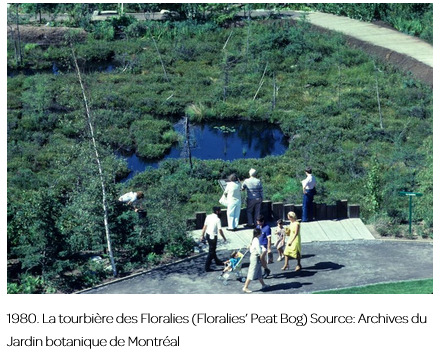
“Canada is the wetlands settler country par excellence” (Giblett 2014, 11), as, much like Montreal, most of its early settlements were built alongside marshes. Its colonial literature has long portrayed these places as murky, monstrous, and ominous.
In the dominant cultural paradigm, marshes were seen as wastelands, which licensed industries to dump toxic waste in their waters or to drain them (35). Seen as dead and inauspicious lands, swamps, marshes, and bogs posed a threat to colonial powers, while being particularly difficult to map, as water and land were inextricably linked. Peat bogs especially are dense and viscous worlds where mosses thrive on top of their own decaying shroud, a process reaching back into the Carboniferous era “when swamps ruled the earth” (203).
---
This story of a garden made of moss not only reveals how Montreal discredited the way the Cree community valued and used wetlands, but offers insight into the colonial governance of Canada and Quebec. [...]
Ultimately, representing peat bogs as “barren lands” speaks to the political figuration of all that is not urban, or, in Giorgio Agamben’s words, as bare life, which, in Western politics, “has the peculiar privilege of being that whose exclusion founds the city of men,” ordered by the “good life” (Agamben 1998, 7). To be preserved, the elusive and ominous peat bog had to be transplanted to the city, where it could be a tamed vehicle [...].
Rethinking geographies beyond anthropocentric [...] views of what defines urbanities and ruralities, might allow us to better understand the constitutive exclusions that created this binary in the first place. In Canada, both urban centers and rural regions have been constituted through the destruction of wetlands. This was repeated in the 1980s, when, just two years after the Floralies championed the city’s green turn, the Notre-Dame peat bog was abandoned. Today, if you were to go there, you would find a dried-out pond, where meridional species have reclaimed their rights.
But perhaps its disappearance from the city's landscape is a sign that wetlands remain unsettled and unsettling.
---
Text by: Isabelle Boucher. “Urban Mires: What Happened to the Garden of Moss?” Heliotrope, Environmental Media Lab at the University of Calgary. 19 April 2023. [Bold emphasis and some paragraph breaks/contractions added by me. Images and captions are shown as published with Boucher’s text in the same article.]
50 notes
·
View notes
Text
My Dream Role as an Environmental Interpreter
Growing up, I loved opportunities to go on camping trips to various provincial parks in Ontario. I remember visiting Balsam Lake, Sibbald Point, Six Mile Lake, Killbear and Wasaga Beach Provincial Park. I loved exploring these natural areas and discovering new landscapes and environments within Ontario.

A picture I took at Cape Breton Highlands National Park in Nova Scotia.
My ideal role as an environmental interpreter would be as a park interpreter at a provincial or national park within Canada. My role as park interpreter would involve assisting visitors to explore park trails and swimming areas while providing informational programs safely and respectfully. I would love to run programs such as nature journaling, biodiversity hikes or games such as Wolf Prowl which allows kids to take on roles as animals in an ecosystem. I would also like to help run evening programs that permit visitors to safely explore the trails in the dark which they might not do on their own. As a park interpreter, I would like to focus some programs on establishing people's relationships with nature and sustainability.
The job of an environmental interpreter would require a variety of skills to deliver effective and meaningful interpretation. The skills I first thought of included plant and animal identification and knowledge of ecology, geology, and environmental stewardship. Additional skills in mapping, GPS, and first aid would also be crucial in a role as a park interpreter. Skills in these areas will allow me to be a reliable source of information that visitors can trust with their questions regarding the natural heritage of conservation areas. These areas of knowledge and skills I have listed are essential for environmental interpretation, however, I do not think they are the most important.
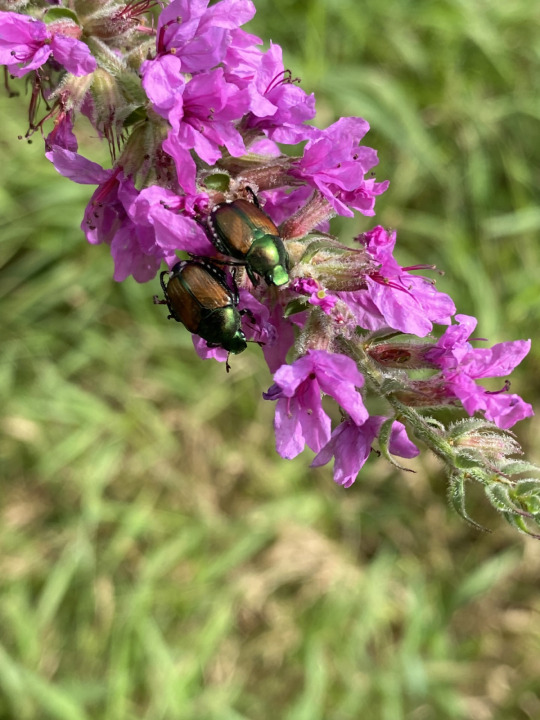
A picture I took of a Japanese beetle (Popillia japonica) on a hike on the Brook Trail in Uxbridge.
Before having the opportunity to work in outdoor education and to read the textbook, Interpreting Cultural and Natural Heritage: For A Better World, I thought knowledge of the environment would be the most important skill to have as an interpreter. However, you could have all the knowledge of nature possible but if you cannot communicate with individuals then you will not be able to effectively share the beauty of nature with others. As described by Beck et al. (2019), communication is the core of cultural and natural interpretation.
In an environmental interpreter role, I would need to be skilled in applying different learning theories and styles to communicate natural surroundings to a diverse group of people. Having the ability to use the Cognitive Development Theory through numerous interpretation forums will allow me to interact with different age groups (Beck et al., 2019). Also, having skills working with multiple intelligences will allow me to connect with a variety of people who learn in different ways (Beck et al., 2019).

A photograph I took in British Columbia at a Natural heritage site.
As an outdoor education intern, I saw many kids with different interests and ways of learning. Some kids connected better to lessons involving games such as Predator-Prey where they got to run around but still learnt about ecosystem functions. Other kids preferred to explore ecosystems through nature journaling or nature photography programs. All kids were able to leave the outdoor education center with new knowledge and new feelings toward the environment through different pathways.
By utilizing my knowledge of the environment with communication and teaching skills I could succeed as an interpreter at a natural heritage site such as provincial or national parks. Communicating my understanding of different environments and sharing my passion for nature would allow me to guide people to form their own connections and ideas of nature.
References
Beck, L., Cable, T. T., & Knudson, D. M. (2019). Interpreting cultural and natural heritage: For A Better World. Sagamore Publishing.
7 notes
·
View notes
Text
My thoughts on Feminism and the Limitations of Online Feminism
I work in the international development field and I have learnt somethings which I feel are useful to my understanding of feminism.
Definition of Feminism
My favourite definition of community development is from USAID which states that "Community Development is the planned progress of all aspects of community's wellbeing". Using that definition as a guide, I define feminism/female liberation as the "planned progress of all aspects of women's and girls' wellbeing".
Below is an image that shows the aspects of personal wellbeing.

[Sidenote: I think physical wellbeing should be a priority for female liberation.]
How to achieve female liberation?
To achieve female liberation, sustained society-wide behavioural change is required. The behavioural change can be voluntary or compelled. For emphasis, to achieve female liberation women and girls would need to change some of our behaviours.
Men and boys have a vested interest in female subordination so they are unlikely to willingly change their behaviours (I personally believe that most humans and animals do not willingly act against their own interests and I think it is unrealistic to expect them to) which is why women and girls would need change their behaviours first.
In addition to individual behavioural change, societal and institutional change is required. They are required to create an enabling environment (laws and infrastructure) to promote and sustain women's and girls' wellbeing and to compel behavioural change for those who are unwilling to change.
People's behaviours are influenced by various factors. Below is an image that shows some influences on behaviour.


Feminist Activism Approach
For those who are interested in going beyond their own personal development (BTW, I don't think there is anything wrong with that), communication for community development is based on the behavioural change model and the socio-ecological model. Below are images that shows those two models respectively.
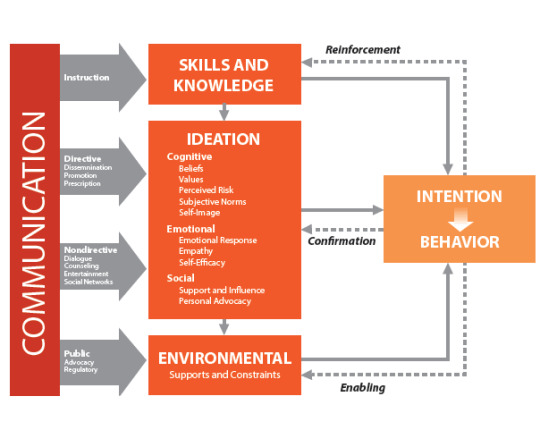
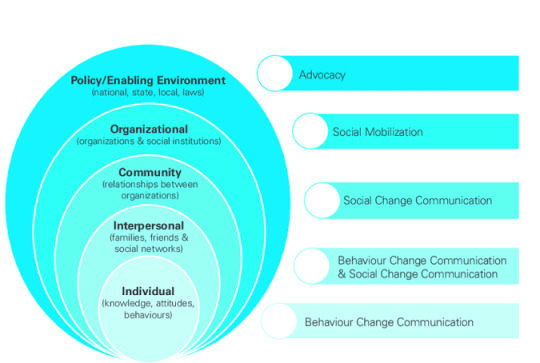
Feminist Activism Online
With online feminism on any platform, behaviour change communication and social change communication are the primary objective that can be realistically achieved. Continous directive and nondirective behaviour change and social change communication to improve knowledge & skills and change attitudes which will hopefully lead to behavioural change is what is most likely happen online.

As the image directly above illustrates, just because someone gets informed doesn't mean they'll change their behaviours. Even laws cannot make people change their behaviours, it can only punish them when they are caught going against the law. I want to emphasize this because feminists on here need to cut yourselves some slack and let go of the feminist saviour complex. International NGOs with billions in funding are not expected to save everyone and neither should you. Given your personal resources, pick a cause dear to you, do what you can without jeopardising your own wellbeing.
[Sidenote: Bridging the gap between intention and practice is where creating an enabling environment through social mobilisation and advocacy comes in.]
While it is necessary to move to offline feminism to see societal change, online feminism is not worthless. Using myself as an example, I gave up on misogynistic beauty practices because I read some books that were recommended on here.
Conclusion
So no, Tumblr feminism is not going to stop FGM in Somalia (or whatever unrealistic expectation people put on Tumblr feminism) but it could share information and knowledge with women in Somalia on how to protect themselves and others. That is also impactful and contributes to promoting the wellbeing of women and girls.
17 notes
·
View notes